 Written by Hulet Smith, OT
Written by Hulet Smith, OT
We understand that being at home with a medical condition that can be addressed with the appropriate care and equipment is preferable to a hospital stay. Since sleep is crucial to recovery and maintaining good health, the appropriate hospital mattress for home use is an important component to successfully managing home care and staying out of the hospital. The right mattress for a hospital bed at home can address medical issues and facilitate quality sleep in ways that a standard mattress cannot.
A hospital bed mattress, sometimes called a medical mattress, or therapeutic mattress, is designed to fit home hospital beds. They specifically address issues we know bed-bound users contend with such as pressure sores, back pain, risk of falling out of bed, and maintaining a healthy sleep environment. They are sized to fit a hospital bed and designed to move as the bed’s platform moves to provide comfort and body support wherever the user needs it.
In our experience, most hospital beds are the equivalent size of a twin XL bed. However, even if the size is comparable, a standard mattress won’t be able to adjust to the bending/flexing of the hospital bed frame in an elevated or seated position. Traditional mattresses aren’t designed to accommodate users who spend more time in bed than out of bed and their medical needs. Hospital bed mattresses, which are generally six to eight inches thick, are more durable than standard mattresses and come in innerspring, foam, low air loss, and alternating pressure designs.
Yes, you do need a special mattress for a hospital bed. A regular mattress isn’t designed to bed along with an adjustable bed platform. We recommend a mattress created for a hospital bed as it’s also more hygienic and is designed to be easily cleaned and sanitized.
In our experience, innerspring hospital bed mattresses range from about $130 to $300. For foam sleep surfaces, mattress toppers start at about $100 and foam mattresses range from $175 to $540. Standard Low-Air Loss and Alternating Pressure mattresses can range from about $300 to about $7000
Innerspring mattresses last about eight years, foam mattresses last up to 10 years, and low air loss and alternating pressure mattresses are expected to last between eight and 10 years.
Hospital beds are larger than regular twin beds, so we don’t recommend a regular twin-sized mattress because it wouldn’t fit the frame correctly, nor would it be able to accommodate the bed’s adjustability.
A mattress wider than 36" is usually considered a Bariatric Mattresses. They come as wide as 76 inches and as long as 94 inches.
A hospital bed overlay is attached to the top of a mattress to improve circulation and help prevent pressure sores from developing. Overlays can be filled with water, air, foam, gel, or a combination and they can be dynamic or static. We provide overlays filled with various substances such as water, gel, air, foam, or any of these in combination.
Medicare will cover hospital bed mattresses for home use when there is a doctor's order stating a condition exists that requires a hospital bed, and the bed itself qualifies as a durable medical device and meets any other Medicare criteria. We don’t accept insurance. Upon your request, we can provide you with an itemized receipt for you to submit to your insurance provider for possible reimbursement.
A regular-size hospital bed is 80 inches long and 36 inches wide, or the size of a twin XL mattress. But there are beds to accommodate larger frames for bariatric patients that range up to 94 inches long and 76 inches wide.
A regular-sized hospital bed is 80 inches long and 36 inches wide, or roughly the size of a twin XL mattress. But there are beds to accommodate larger frames that range up to 94 inches long and 54 inches wide. Typically we know a bariatric hospital mattress will be bigger and provide a higher weight capacity. Choosing a mattress that is longer than the user is tall will contribute to the patient’s comfort and ensure plenty of room for position adjustments.
Proper alignment, created by the appropriate level of support in a mattress, will defend against back pain and provide the most restful environment for a user. The mattress should push up on the curves and contours of the body to counteract body weight and keep the body aligned. In our experience as occupational therapists, mattresses that are too firm won’t fill in the body’s contours with proper support, and a mattress that is too soft won’t support the body’s neutral alignment.
The effects of aging are often what makes a hospital bed a necessity, so choosing a hospital bed mattress for home use often includes considering a senior’s needs. Chronic sleep issues are common in the elderly, often due to pain in the neck, shoulders, back, and hips. We recommend a mattress that provides the proper amount of structural support that will help minimize aches and pains and contribute to a more restful sleep.
With so many options and design features, we know choosing the best hospital mattress for home use depends on the user’s health, what features will provide the most comfort and the budget. Thoughtful consideration will help you narrow down your options so you can find the mattress that is the best fit for the bed and the patient.
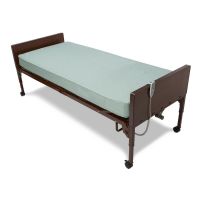 | Vinyl Innerspring Mattresses by Medline View Product |
Innerspring mattresses, made with evenly distributed coils, are best for users who aren’t entirely bedridden and don’t spend several hours each day out of bed. They are our least expensive type of home hospital bed mattress and come in your choice of firmness, so patient comfort and preference can be accommodated. This design promotes good airflow, which keeps the user cool and dry, creating a more comfortable sleep environment that also supports skin health.
Best Innerspring Hospital Mattress: Vinyl Innerspring Mattresses by Medline
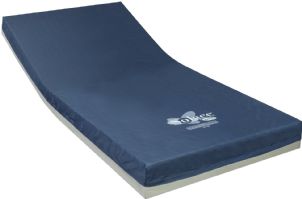 | Solace Prevention Therapeutic Foam Mattress by Invacare View Product |
Foam mattresses have shock-absorbing qualities, cradling the user in cozy comfort, which can help decrease the incidence of back pain that patients who spend a lot of time in bed sometimes experience. These mattresses are an economical option, and although they don’t conduct airflow as well as an innerspring model, they are more lightweight. We know in models that have different layers, zones, and densities, pressure is redistributed to help prevent pressure ulcers.
Best Foam Hospital Mattress: Solace Prevention Therapeutic Foam Mattress by Invacare
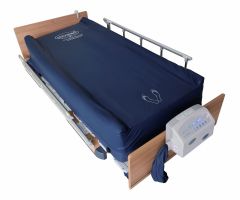 | Low Air Loss Mattress with Alternating Pressure, Self-Lateral-Wave Rotation, Side Bolster, and Remote Control | OB-2600 StandardAir View Product |
With tiny laser-drilled surface holes, low-air loss mattresses constantly blow out air, causing the patient to “float” on top of the mattress. Reducing the pressure of the skin on the mattress surface reduces pressure on weight-bearing areas and helps heal bedsores. We love that the airflow also keeps moisture away from the skin, helping to maintain a dry, healthy, and comfortable sleep environment. Low-air loss mattresses are beneficial for people who have developed bedsores and are unable to reposition themselves regularly.
Best Low Air Loss Mattress: ObboMed OB-2600 StandardAir Mattress - Alternating Pressure and Low Air Loss | Self-Lateral-Wave Rotation
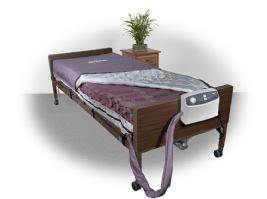 | Drive Medical Alternating Pressure Low Air Loss Mattress System View Product |
Alternating pressure mattresses provide active therapy for bedsores. They keep the pressure points alternating throughout the body, with air bladders positioned laterally or lengthwise that inflate and deflate and inflate slowly up and down the length of the mattress. This redistribution of pressure over the air bladders stimulates blood flow and supports skin healing when pressure sores are present. We love that they also keep fluids and lung secretions moving, making them suitable for people who spend the majority of their time in bed and can’t reposition themselves.
Best Alternating Pressure Hospital Mattress: Drive Medical Alternating Pressure Low Air Loss Mattress System
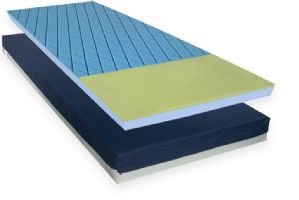 | Drive Medical Gravity 7 Pressure Relief Mattress View Product |
We know side sleepers require more pressure relief, so an innerspring mattress isn’t the best choice for side sleepers. With foam or air mattresses, one with a perimeter or bolster will help keep a side sleeper from rolling out of bed. Check out How to Choose the Best Pressure Relief Mattress and our article 5 Best Pressure Relief Mattresses for more in-depth information.
Best Hospital Mattress for Side Sleepers: Drive Medical Gravity 7 Pressure Relief Mattress
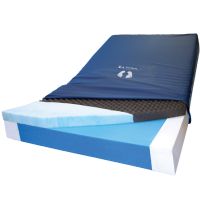 | RLX Foam Mattress for Pressure Redistribution | Standard and Bariatric Sizes View Product |
In our experience, users who spend most of their waking hours in bed are at a higher risk of developing pressure wounds. A hospital bed mattress that redistributes weight will defend against bedsores. Innerspring mattresses are the least effective choice for preventing and healing bedsores. Foam mattresses that accommodate weight and pressure in different areas of the body help prevent bedsores. Low air loss and alternating pressure mattresses prevent skin shearing and keep pressure ulcers from forming, while helping heal bedsores that are already present.
Best Hospital Mattress for Pressure Sores: Low Air Loss Mattress Alternative by United Mattress
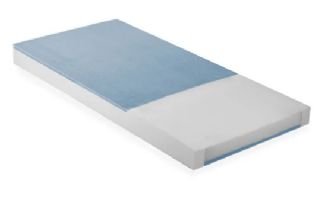 | Pressure Reducing Mattress Series 6500 Dynamic Elite by Drive Medical View Product |
Foam mattresses are the most common type of hospital bed mattress because of the support they offer, which helps alleviate patient back pain. For hospital bed users with back and pelvic issues who spend time in bed for more than just sleeping, we recommend layered foam mattresses, because they have a soft top layer with small air channels and a firm bottom layer providing necessary back support.
Best Hospital Mattress for Back Pain: Pressure Reducing Mattress Series 6500 Dynamic Elite
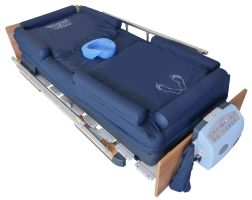 | Low Air Loss Mattress with Inflatable Guardrail and Bed Pan Access | OB-2680 PremiumAir View Product |
Falling from bed has the potential to cause serious injury. Home hospital bed mattresses with bolsters also referred to as perimeter mattresses, are designed to minimize the risk of a fall by guiding the sleeper away from the side of the bed and toward the middle of the mattress. We know this is typically accomplished with foam inserts around the perimeter either built into the mattress or in the form of a mattress cover.
Best Hospital Mattress for Fall Risk: PremiumAir Low Air Loss Mattress for Pressure Ulcer Treatment
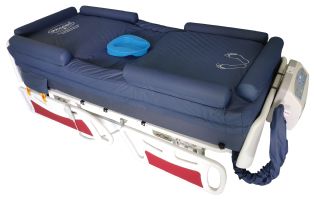 | Low Air Loss Mattress with 3 Layers, Bed Pan Access, and Inflatable Guardrail | OB-3682 UltraAir View Product |
Innerspring mattresses can be counted on for about eight to ten years of service, keeping in mind they are not meant for people who spend the majority of their time in bed. Based on our experience, foam hospital bed mattresses have the longest lifespan, with up to 10 years of expected service. They are best for users who will benefit from firm structural support as well as some pressure-relieving features. Air bed mattresses have an expected service life of eight to 10 years, are the most expensive type of mattress, and are generally the most comfortable for users who benefit from the support plus a cooler sleep surface and drier sleep environment.
Best Long-Term Use Hospital Mattress: UltraAir Alternating Pressure Mattress for Pressure Ulcer Prevention
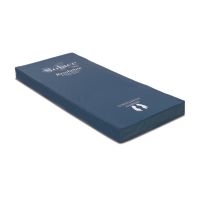 | Solace Resolution Glissando Heavy Duty | Mattress by Invacare View Product |
Much attention is paid to airflow and accompanying cooler sleep surfaces. But for people who get cold easily or who have a lower body temperature, a heat-retaining mattress is preferable. We recommend a foam mattress because they are the best at holding heat and creating a warmer sleep space.
Best Hospital Mattress for Cold Sensitivity: Solace Resolution Glissando Heavy Duty | Mattress by Invacare
Choosing home care when dealing with a medical condition has many benefits. It also brings along some additional stressors and challenges, like ensuring you have done all you can to create the healthiest possible environment. Choosing the correct mattress for a home hospital bed helps ensure proper rest for the patient, eliminates strain on caregivers, and addresses physical issues like safety, pain, and pressure ulcers.
With so many options and design features, choosing the best hospital mattress for home use depends on the user’s health, what features will provide the most comfort, and the budget. Some research and thoughtful consideration will help you narrow down your options so you can find the mattress that is the best fit for the bed and the patient. Being confident in your choice of mattress will help everyone rest easier. For more information, tips, and tricks on this subject, please check out our blog Caregiver University.

Co-founder/CEO of Rehabmart, Pediatric Occupational Therapist, husband, and father. Passionate about connecting special needs kids with superb nutrition, sensory integration, and complementary health strategies. Excited about Rehabmart's mission to become the premier online educational platform which empowers caregivers by spotlighting innovative devices and interventions to achieve optimal patient response and recovery.